Österreich |
|
|
|
| Übersicht – Contents: | |
|
weitere Seiten zu Österreich: (historische Flaggen und Wappen) |
further Austria pages: (historical Flags and Coats of Arms) |
Diese Seite ist Teil des Projektes
Österreich |
|
|
|
| Übersicht – Contents: | |
|
weitere Seiten zu Österreich: (historische Flaggen und Wappen) |
further Austria pages: (historical Flags and Coats of Arms) |
Flaggen – Flags: |
|
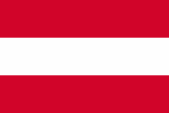 |
National- und Handelsflagge – National and merchant flag, Seitenverhältnis – ratio = 2:3, Quelle/Source nach/by: Dr. Peter Diem www.peter-diem.at |
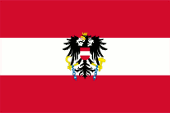 |
Staats- und Dienstflagge und Flagge des Präsidenten
– State and official flag and flag of the President, Seitenverhältnis – ratio = 2:3, Quelle/Source nach/by: Dr. Peter Diem www.peter-diem.at |
historische Flaggen – historical Flags: |
|
 |
1918–1938, National- und Handelsflagge – National and merchant flag, Seitenverhältnis – ratio = 2:3, Quelle/Source nach/by: Dr. Peter Diem www.peter-diem.at |
 |
1918–1934, Staats- und Dienstflagge und Flagge des Präsidenten – State and official flag and flag of the President, Seitenverhältnis – ratio = 2:3, Quelle/Source nach/by: Dr. Peter Diem www.peter-diem.at |
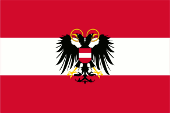 |
1934–1938, Staats- und Dienstflagge und Flagge des Präsidenten – State and official flag and flag of the President, Seitenverhältnis – ratio = 2:3, Quelle/Source nach/by: Dr. Peter Diem www.peter-diem.at |
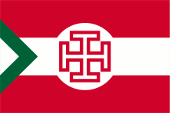 |
1935–1938, Flagge, im Inland gleichberechtigt neben der Nationalflagge zu hissen – Flag to hoist inland, equally next to the national flag, Seitenverhältnis – ratio = 2:3, Quelle/Source nach/by: Dr. Peter Diem www.peter-diem.at |
| Flaggen der Patrouillenboote (Donau-Flotte) – Flags of the Patrol-Boats (Donau River Fleet): | |
 |
1918–1926, Seitenverhältnis – ratio = 2:3, Quelle/Source nach/by: Dr. Peter Diem www.peter-diem.at |
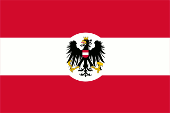 |
1926–1934, Seitenverhältnis – ratio = 2:3, Quelle/Source nach/by: Dr. Peter Diem www.peter-diem.at |
 |
1934–1938, Seitenverhältnis – ratio = 2:3, Quelle/Source nach/by: Dr. Peter Diem www.peter-diem.at |
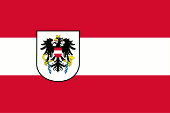 |
1955–1984, Seitenverhältnis – ratio = 2:3, Quelle/Source nach/by: Dr. Peter Diem www.peter-diem.at |
 |
1984–2006, Seitenverhältnis – ratio = 2:3, Quelle/Source nach/by: Dr. Peter Diem www.peter-diem.at |
| Flagge der Strompolizei – Flag of the River Police: | |
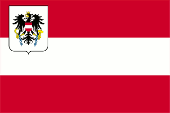 |
1955–1988, Seitenverhältnis – ratio = 2:3, Quelle/Source nach/by: Jürgen Kaltschmitt |
Bedeutung/Ursprung der Flagge – Meaning/Origin of the Flag: |
|
| Die Flagge Österreichs zeigt drei waagrechte Streifen in Rot, Weiß und Rot. Die Farben stammen aus dem frühen 13. Jahrhundert, wurden zu den Farben des Herzogtums Österreich (siehe unten bei Wappen), und wurden schließlich im Jahre 1786 als Marine- und Kriegsflagge für die gesamten Österreichisch-Habsburgischen Gebiete eingeführt. | The flag of Austria shows three horizontal stripes in red, white and red. The colours have their roots in the early 13th century became to the colours of the Duchy of Austria (see below for coat of arms) and became finally in the year 1786 introduced as naval and war flag for the whole Austrian Habsburgs territories. |
| Für den Deutschen Bund, der von Österreich dominiert war, wurde 1848 eine schwarz-rot-goldene Flagge eingeführt. Diese Flagge wurde offiziell nur bis 1850 verwendet, doch gerade die österreichischen Truppen präsentierten sich noch 1864 im Deutsch-Dänischen Krieg unter dieser Flagge. | For the
German Confederation, which was dominated by Austria, in 1848 was introduced
a black-red-golden flag . This flag was officially used only to 1850, but just the Austrian troops presented themselves still in 1864 – in the German-Danish War – under this flag. |
| Seitdem verkörperte, nicht nur in Österreich, die schwarz-rot-goldene Flagge auch den großdeutschen Gedanken, den Zusammenschluss aller Staaten deutscher Sprache. | Since then, the black-red-golden flag embodied, not only in Austria, the pan-German idea, the interconnection of all countries of German language. |
| Das wurde 1918, nach dem Zusammenbruch Österreich-Ungarns kurz wieder aktuell, als sich die Republik Deutsch-Österreich konstituierte, die sich in einen gesamtdeutschen Staat einbringen wollte, was letztlich 1919 durch die Siegermächte des Ersten Weltkriegs unterbunden wurde. | This became currently relevant again in 1918, after the collapse of Austria-Hungary, as the Republic of German Austria was constituted, which wanted to get involved in an all-German government, which was ultimately in 1919 prevented by the victorious powers of World War I. |
| Am 12.11.1918 wurde die rot-weiß-rote Flagge eingeführt und bis zum Anschluss Österreichs an das Deutsche Reich am 13.03.1938 beibehalten. Noch vor der Kapitulation des Deutschen Reiches wurde diese Flagge am 01.05.1945 per Gesetz als Flagge Österreichs wieder eingeführt, und 1984 bestätigt. Die Farbenkombination von Rot, Weiß und Rot geht auf den Bindenschild von Herzog Leopold V. aus dem Hause Babenberg zurück. Die Legende erzählt, dass der Schild im Jahre 1191 entstand, als der Herzog nach der Schlacht von Akko den Gürtel von seinem blutigen Gewand löste, und so das Symbol des weißen Streifens auf rotem Untergrund schuf. Erstmals nachgewiesen ist der Bindenschild jedoch auf dem Siegel des letzten Babenbergers Friedrich II. aus dem Jahre 1230. | On the
12th of November in 1918 the red-white-red flag was introduced and it was
maintained untill the annexion of Austria to the German Empire on the 13rd
of March in 1938. Even before the capitulation of the German Empire this
flag was re-introduced by law on the 1st of May in 1945 as the flag of
Austria and confirmed in 1984. The colours combination of red, white and red has its roots in the band-shield of Duke Leopold V. from the House of Babenberg. The legend tells that the shield arised in the year 1191 as the duke after the Battle of Akko took of his belt from his bloody raiment and in this way created the symbol of the white stripe on red undercoat. For the first time proven is the band-shield however on the seal of the last Babenberger Frederick II. in the year 1230. |
| Nach der Niederlage im Ersten Weltkrieg kam es in Österreich-Ungarn zur Revolution. Die Habsburger Monarchie wurde gestürzt und am 12.11.1918 die Republik Österreich proklamiert. Die die nicht-deutschen Landesteile spalteten sich jedoch in eigenen Staaten ab (z.B. Ungarn, Tschechoslowakei ...). Als Nationalflagge wurde eine Flagge mit drei waagrechten Streifen in Rot, Weiß und Rot ohne Wappen angenommen. Die Staatsflagge wurde noch um die Darstellung eines schwarzen Adlers mit nur einem Kopf, einer Mauerkrone, Sichel und Hammer (Symbole von Bürgerstand, Bauern und Arbeiter) in den Krallen, und einem rot-weiß-roten Brustschild ergänzt. | After the
defeat in the First World War occured in Austria-Hungary the revolution. The
Habsburg monarchy became overthrowed and on the 12th of November in 1918 was
proclaimed the Republic of Austria. The non-German parts of the country
separated however in own states (e.g. Hungary, Czechoslovakia ...). As
national flag was adoped a flag with three horizontal stripes in red, white
and red without a coat of arms. The state flag became added by the depiction of a black eagle with only one head, a mural crown, sickle and hammer (symbols of the bourgeois status, farmers and workers) in the claws and a red-white-red chest shield. |
| Am 01.05.1934 wurde in Folge des Bürgerkriegs eine neue Verfassung verabschiedet und damit die Staatsflagge geändert. Es wurde der doppelköpfige Habsburger Adler in die Mitte der Flagge gesetzt. | On the 1st of May in 1934 was passed a new constitution as result of the civil war and in this way changed the state flag. There was set the twin-headed Habsburg Eagle in the middle of the flag. |
| Seit 1935 durfte die Flagge der Vaterländischen Front (VF) – ein Zusammenschluss aller regierungstreuen Gruppen in Österreich, die Marxismus und Nationalsozialismus ablehnten – im Inland gleichberechtigt neben der Nationalflagge gehisst werden. Das wurde am 28.12.1936 im "Gesetz über die Bundesflagge" bestätigt. In der Praxis wurde aber oft nur die Flagge der VF verwendet, auch ohne den grünen Sparren am Liek, der die Wälder Österreichs symbolisieren sollte. Die Flagge der VF glich im Grundaufbau der Flagge Österreichs, drei Streifen in Rot, Weiß und Rot, jedoch wurde noch der grüne Sparren am Liek ergänzt, und es wurde in der Mitte der Mitte der Flagge eine weiße Scheibe aufgelegt, auf der ein rot umrandetes Krukenkreuz zu sehen war. Ein Krukenkreuz ist ein verkürztes Jerusalemkreuz, es wurde schon ab 1925 von der Republik Österreich auf Münzen und Orden verwendet. | Since
1935 it was allowed to hoist the flag the Fatherland Front (FF) inland
equally next to the national flag. The FF was a merger of all pro-government
groups in Austria, which rejected marxism and national-socialism. This was
confirmed on 28th of December in 1936 by the "Law on the federal flag". In
practice, however, only the flag of the FF was often used, even without the
green rafters at the leech, which should symbolize the Austrian forests. The flag of the FF used the basic structure of the Austrian flag, three stripes in red, white and red, but the flag was added by green rafters at the leech and by a white disk in the middle, on which was to see red edged crook cross. A crook cross is a shortened Jerusalem cross, it was already used by the Republic of Austria from 1925 on coins and medals. |
| Mit dem Anschluss Österreichs an das Deutsche Reich am 13.03.1938 wurde dessen Flaggensystem übernommen. | By the annexion of Austria to the German Empire on the 13th of March in 1938 was taken over its flag system. |
| Die Flaggen der Österreichischen Bundesländer werden mit oder ohne Wappen gezeigt. Amtlich verwendet, tragen sie immer das Wappen, jedoch darf auch die Bevölkerung Flaggen mit Wappen verwenden. | The flags
of the Federal States of Austria are used with or without the coat of arms. For official use, however, they always show it. The general population is permitted to use this format as well. |
| Die Farben der Flagge sind per Bundesverfassungsgesetz von 1981 – Artikel 8a – vorgeschrieben, jedoch als "rot-weiß-rot", ohne sie näher zu spezifizieren. Lediglich in Vorschriften der österreichischen Armee wird auf Pantone 186 c als Farbton für das Rot hingewiesen. Für die österreichischen Bundesländer scheint es keine gesetzlichen Regelungen zu geben, die Farben der Flaggen werden, da offenbar nicht definiert, in der Praxis in einem gewissen Standardbereich wiedergegeben. |
The colours of the flag
are prescribed by the Federal Constitutional Law of 1981 - Article 8a - but
as "red-white-red" without specifying them in more detail. Only regulations
of the Austrian army refer to Pantone 186 c as the colour shade for the red.
There do not seem to be any legal regulations for the Austrian federal states, the colours of these flags are, since apparently not defined, are reproduced in practice in a usual standard range. |
| Quelle/Source: Flaggen Wappen Hymnen, Die Welt der Flaggen, Volker Preuß, Jürgen Kaltschmitt, Wikipedia (DE) | |
heutiges Wappen – today's Coat of Arms: |
|
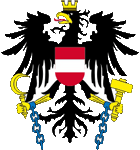 |
Wappen Österreichs – coat of arms of Austria, Quelle/Source nach/by: Corel Draw 4 |
historische Wappen der Republik – historical Coats of Arms of the Republic: |
|
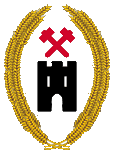 |
1918, Entwurf zum Wappen der Republik Deutsch-Österreich – Draft of the coat of arms of the Republic of German-Austria Quelle/Source: nach/by: Jürgen Kaltschmitt |
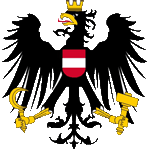 |
1919–1934, Wappen der Republik Österreich – Coat of arms of the Republic of Austria, Quelle/Source nach/by: Corel Draw 4, Dr. Peter Diem www.peter-diem.at |
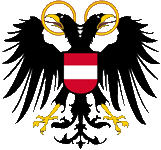 |
1934–1938, Wappen des Bundesstaats Österreich – Coat of arms of the Federal State of Austria, Quelle/Source nach/by: Dr. Peter Diem www.peter-diem.at |
Bedeutung/Ursprung des Wappens – Meaning/Origin of the Coat of Arms: |
|
| Das Staatswappen zeigt seit dem 21.10.1919 einen schwarzen Adler mit einer Mauerkrone, Sichel und Hammer (Symbole von Bürgerstand, Bauer und Arbeiter), auf der Brust einen rot-weiß-roten Schild. Am 01.05.1934 wurde dieses Wappen durch die Darstellung eines doppelköpfigen Habsburger Adlers ersetzt. | The coat of arms shows since the 21st of October in 1919 a black eagle with a mural crown, sickle and hammer (symbols of the bourgeois status, farmers and workers), on the chest a red-white-red shield. On the 1st of May in 1934 was this coat of arms substituted by the depiction of a twin-headed Habsburg Eagle. |
| Im Jahre 1918 wurde zunächst ein anderes Wappen für die Republik Deutsch-Österreich vorgeschlagen. Es zeigte eine schwarze Burg (Bürgertum), rote, gekreuzte Hämmer (Arbeiter) und goldene Ähren (Bauern). | In 1918, initially another coat of arms was proposed for the Republic of German Austria . It showed a black castle (bourgeoisie), red, crossed hammers (workers) and golden ears of corn (farmers). |
| Vom 13.03.1938 bis zum 01.05.1945 gehörte Österreich zum Deutschen Reich. Nach dem Kriege wurde wieder das Wappen von 1919 eingeführt, allerdings kamen gesprengte Ketten an den Beinen des Adlers als Symbol der Befreiung vom Nationalsozialismus hinzu. | From the 13th of March to the 1st of May in 1945 Austriua belonged to the German Empire. After the war was re-introduced the coat of arms of 1919 but added by broken chains on the legs of the eagle as symbol for the liberation from national socialism. |
| Das gegenwärtige Wappen ist in der Österreichischen Verfassung (Abteilung 1, Artikel 8a Abs. 2) beschrieben. "Das Wappen der Republik Österreich (Bundeswappen) besteht aus einem freischwebenden, einköpfigen, schwarzen, golden gewaffneten und rot bezungten Adler, dessen Brust mit einem roten, von einem silbernen Querbalken durchzogenen Schild belegt ist. Der Adler trägt auf seinem Haupt eine goldene Mauerkrone mit drei sichtbaren Zinnen. Die beiden Fänge umschließt eine gesprengte Eisenkette. Er trägt im rechten Fang eine goldene Sichel mit einwärts gekehrter Schneide, im linken Fang einen goldenen Hammer." | The
present arms are set out in the Austrian Constitution (Section 1, article 8a
(2)), which states: "The Arms of the Republic of Austria (Federal Arms) are: a free-standing, single-headed eagle sable, armed or and tongued gules, on its breast an escutcheon gules with a fess argent. The eagle bears on its head a mural crown or with three visible towers. Both legs are chained with a broken iron chain. The eagle holds in its right claw a sickle or with the blade turned inwards, and in its left claw a golden hammer."
|
| Das Schild in den Farben Rot, Weiß und Rot wird auch Bindenschild genannt, und ist sehr alt. Es kam über die gleich gestaltete Lehensfahne der Eppensteiner über die steirischen Traungauer und die steirischen Otakare 1192 auf die österreichischen Babenberger. Die Eppensteiner waren ein bedeutendes Adelsgeschlecht, aus dessen Reihen einige der Herzöge von Kärnten kamen. Als die Eppensteiner 1122 ausstarben, ging der gesamte Besitz – mit Wappen und Lehensfahne – an die steirischen Traungauer. Der Bindenschild kam schließlich an Österreich, als die Traungauer 1192 ausstarben, und das Erbe – wiederum mit Wappen und Lehensfahne – an die Babenberger kam, die damals Herzöge von Österreich waren. | The shield in the colors red, white and red is also called Bindenschild ("cummerbund"), and it is very old. It came with the same shaped feudal banner of the house of Eppenstein to the house of Traungau in Styria to the house of the Styrian Otakars in 1192 to the house of Babenberg in Austria. The house of Eppenstein was an important noble family, from whose ranks some of the Dukes of Carinthia came. As the house of Eppenstein extincted in 1122, the entire heritage – including coat of arms and the feudal banner – came to the house of Traungau from Styria. The shield finally came to Austria, as the house of Traungau extincted in 1192, and the heritage – with crest and feudal banner again – came to the house of Babenberg, the Dukes of Austria at the time. |
| Es gibt allerdings eine weit verbreitete Legende, welche die Entstehung des Bindenschilds sehr anschaulich darstellt: Der Babenberger Leopold V., Herzog von Österreich, hatte während des Dritten Kreuzzugs an der Belagerung von Akkon teilgenommen (1189-1191), und war derartig heftig an Zweikämpfen beteiligt, dass sein tunikaähnlicher Waffenrock vollständig von "Heidenblut" getränkt war. Als er seinen breiten Schwertgurt abnahm, war auf dem Gewand an dieser Stelle nur noch ein breiter weißer Streifen zu sehen. Leopolds eigenes Banner war in der Schlacht verlorengegangen, so dass er von Kaiser Heinrich VI. in Erinnerung an seine Heldentaten ein Banner mit diesem Bild – drei Streifen in Rot, Weiß und Rot – verliehen bekam. In Wirklichkeit hatte der König von England sein Banner in den Stadtgraben von Akkon werfen lassen. Aber das ist eine andere Geschichte. Lesen Sie mehr dazu hier. |
However, there is a widespread legend, showing the origin of the shield very
descriptively: Leopold V. from the house of Babenberg, Duke of Austria, had participated in the siege of Acre (1189-1191) during the Third Crusade, and he was so violently involved that his tunic cape was completely soaked from the blood of the moors. When he took off his broad sword belt, only a broad white stripe was to see on the garment at this point. Leopold's own banner was lost in the battle, so he got awarded a banner with this picture – three stripes in red, white and red – from Emperor Henry VI. in memory of his exploits. In reality, the king of England throwed his banner in the moat of Acre. But this is another story. Read more here. |
| Quelle/Source: Flaggen Wappen Hymnen, Volker Preuß, Jürgen Kaltschmitt | |
|
Lesen Sie hier:
Hintergründe, Geschichte und Fakten zum Thema "Der Adler in der Heraldik"; Ausführungen, Varianten und Entwicklung. |
 |
Landkarten – Maps: |
Lage – Position: |
Landkarte des Landes – Map of the Country: |
| Die Bundesländer Österreichs – the Federal States of Austria: |
|
Burgenland • Kärnten
(Carinthia) • Niederösterreich (Lower Austria) |
|
|
Zahlen und Fakten – Numbers and Facts: |
|
|
|
|
|
|
|
|
|
|
|
|
|
|
|
|
|
|
|
|
| • Reich der Österreichischen Habsburger • Kaiserreich Österreich • Österreich-Ungarn |
• Empire of the Austrian Habsburgs • Empire of Austria • Austria-Hungary |
Geschichte: |
|
Antike
· im heutigen Österreich siedeln Räter und Kelten ab 14 v.Chr. · römische Eroberung, Errichtung der Provinzen Noricum und Pannonia superior 166–168 · Einfälle der germanischen Stämme der Markomannen, Quaden und Langobarden 233 · Einfälle der Quaden 254 · Einfälle der Markomannen 409–452 · Hunneneinfälle 476 · Absetzung des letzten römischen Kaisers Romulus Augustulus, Ende des (West)Römischen Reiches, das heutige Österreich gehört bis 553 zu den Reichen der Ostgoten und der Langobarden, Besiedlung durch Bajuwaren 788 · Eroberung durch das Frankenreich der Karolinger 795 · Bildung der "Awarischen Mark" 843/870/880 · bei der Teilung des Frankenreiches kommt die Awarische Mark zum Ostfänkischen Königreich (später Deutsches Reich genannt) 900–955 · Ungarneinfälle 955 · Schlacht auf dem Lechfeld, Sieg über die Ungarn, Bildung der Bayerischen Ostmark, 996 erstmals "Ostarrîchi" genannt 976 · Bildung des Herzogtums Kärnten, der Markgrafschaften Ostmark (Österreich), Steiermark und Krain, der Grafschaften Tirol und Görz, des Erzbistums Salzburg, des Bistums Trient und des Patriarchats von Aquileia 976 · das Haus Babenberg wird zu den Markgrafen der Ostmark 1156 · Österreich (Ostmark) wird Herzogtum 1180 · Steiermark wird Herzogtum 1192 · die Steiermark kommt an die Babenberger 1246 · Aussterben der Babenberger, Österreich und Steiermark kommen an die böhmischen Premysliden 1273 · Rudolf von Habsburg wird deutscher König 1278 · Rudolf von Habsburg besiegt die böhmischen Premysliden und erwirbt Österreich und Steiermark 1335 · die Habsburger erwerben Kärnten und Krain 1363 · die Habsburger erwerben Tirol 1374 · die Habsburger erwerben Istrien (die Küste verbleibt bei Venedig) 1382 · die Habsburger erwerben Triest 1394 · Krain wird Herzogtum 1438 · das Haus Habsburg stellt ab diesem Jahr die Kaiser des Heiligen Römischen Reiches Deutscher Nation (Wahlkaisertum) 1477 · die Habsburger erwerben die Freigrafschaft Burgund 1496 · die Habsburger sichern sich Spanien durch Heirat 1500 · die Habsburger erwerben die Grafschaft Görz 1526 · die Habsburger erwerben durch Erbschaft Böhmen, Schlesien, die Lausitz von den Luxemburgern, sowie nach der Schlacht von Mohács die Ungarische Krone, das Königreich Ungarn bleibt zwischen Österreich und den Türken als schmaler Streifen bestehen, Ungarn selbst geht zu 80% an die Türken 1556 · das Haus Habsburg teilt sich in eine spanische und eine österreichische Linie 1683 · Abwehr der Türken vor Wien 1697 · Schlacht von Karlowitz, die Türken verlieren Ungarn, Slavonien, Kroatien und das Fürstentum Siebenbürgen an Habsburg 1718 · Frieden von Passarowitz, Habsburg erwirbt das Banat 1701–1713 · Aussterben der Spanischen Habsburger, Spanischer Erbfolgekrieg 1713 · Frieden von Utrecht, die ehemals Spanischen Niederlande (Belgien), Sardinien, Neapel, Parma und Piacenza kommen an Österreich (Haus Habsburg österreichische Linie), Spanien geht an die Bourbonen 1740–1748 · Österreichischer Erbfolgekrieg, quasi Pattsituation, Österreich verliert jedoch Schlesien an Preußen, Parma und Piacenza an die spanischen Bourbonen 1772 · Erste Polnische Teilung, Österreich erwirbt Galizien 1775 · Österreich erwirbt die Bukowina 1795 · Dritte Polnische Teilung, Österreich erwirbt Kleinpolen (Westgalizien) 1797–1809 · Französische Revolutionskriege: ein Teil Österreichs (Steiermark) wird 1797 von den Franzosen besetzt 1797 · Friede von Campo Fòrmio nach den Französischen Revolutionskriegen, Österreich verliert die Österreichischen Niederlande und die Lombardei, erhält aber die Republik Venedig 1803 · Reichsdeputationshauptschluss, Österreich erhält Trient und Brixen 1804 · Franz II. von Habsburg, Kaiser des Heiligen Römischen Reiches Deutscher Nation wird als Franz I. auch Kaiser von Österreich, Gründung des Kaiserreichs Österreich 1805 · Friede von Preßburg nach dem 3. Koalitionskrieg, Österreich verliert Venetien, Tirol und Vorarlberg 1806 · Kaiser Franz II. legt die Krone des Heiligen Römischen Reiches Deutscher Nation nieder, das Deutsche Reich endet 1809 · Friede von Wien, Österreich verliert Salzburg, das Innviertel, Westgalizien und Teile von Ostgalizien und tritt Istrien, Triest, Görz, Krain, Kärnten, Kroatien, und Dalmatien an Frankreich ab, die 1810 zu den französischen "Illyrischen Provinzen" zusammengefasst werden 1813 · Kriegserklärung an Frankreich (Napoléon) 1814 · Wiener Kongress, das Kaiserreich Österreich (Haus Habsburg) erhält die 1809 verlorenen Gebiete zurück, sie werden zum Habsburgischen Königreich Illyrien zusammengefasst, Dalmatien und Kroatien werden wieder an Ungarn (unter den Habsburgern, Teil des Kaiserreichs Österreich) angeschlossen, Österreich erhält ab 1815 den Vorsitz im Deutschen Bund 1848/1849 · Revolution in Wien, Bürgerkrieg zwischen Ungarn und Kroaten, Aufstände in Prag, Mailand und Venedig, daraufhin dankt Kaiser Ferdinand I. ab und Franz Joseph I. von Habsburg wird neuer Kaiser, die Aufstände werden niedergeschlagen und er erlässt eine neue Verfassung: die Titular-Erblande der Habsburger im Kaiserreich Österreich werden zu Kronländern mit eigenen Landtagen umgewandelt, der dalmatische Landtag lehnt den Anschluss an Kroatien ab, das Königreich Dalmatien wird ein eigenes Kronland der österreichischen Krone, Kroatien und Slawonien werden zum "Königreich Kroatien und Slawonien" vereinigt, das als Nebenland bei der ungarischen Krone verbleibt 1859 · Österreich verliert die Lombardei an Sardinien 1866 · Bruderkrieg (Preußen gegen den Deutschen Bund), Preußen siegt, Zerschlagung des Deutschen Bundes, Österreich verliert Venetien, Gründung des Norddeutschen Bundes (ohne Österreich) unter der Führung Preußens 08.02.1867 · Österreichisch-Ungarischer Ausgleich, gleiches Recht für beide Landesteile, Entstehung der Doppelmonarchie Österreich-Ungarn, Österreich: bestehend aus den österreichischen Kronländern, Ungarn: bestehend aus Ungarn selbst und seinen Nebenländern, das Haus Habsburg stellt in einer Person den Kaiser von Österreich und den König von Ungarn, Einrichtung von gemeinsamen Ministerien in Außenpolitik, Finanzen und Verteidigung 1878 · Berliner Kongress, Österreich-Ungarn erhält Bosnien (einschl. Herzegowina) 1908 · Bosnien wird Österreich-Ungarn als Reichsland angegliedert 28.06.1914 · Ermordung des österreichischen Thronfolgers Franz Ferdinand und seiner Frau, Beginn des Ersten Weltkriegs (1914–1918), das Deutsche Reich ist dabei Verbündeter Österreichs 28.10.1918 · Separation der Tschechoslowakei 19.10.1918 · Separation Jugoslawiens 01.11.1918 · Separation Ungarns 03.11.1918 · Waffenstillstand 11.11.1918 · Kaiser Karl I., verzichtet in Österreich auf die Ausübung seiner Herrschaft 12.11.1918 · Proklamation von Deutsch-Österreich zur Republik Österreich als Bestandteil der „Deutschen Republik“ 13.11.1918 · Karl IV. (Karl I.), verzichtet in Ungarn zeitweilig auf die Ausübung seiner Herrschaft, Ende der Habsburger Monarchie 10.09.1919 · Friedensvertrag von Saint-Germain, Verzicht auf Südtirol und deutsche Gebiete in Böhmen, Anerkennung der Tschechoslowakei, Polens, Ungarns und Jugoslawiens, Verzicht auf einen Beitritt zum Deutschen Reich, Zahlung von hohen Reparationen 1920–1934 · Phase wirtschaftlicher Krisen und Bürgerkrieg 01.05.1934 · neue Verfassung, die Bezeichnung "Republik Österreich" wird abgeschafft und durch "Bundesstaat Österreich" ersetzt 11.03.1938 · Machtergreifung durch den Nationalsozialisten Seyß-Inquart 13.03.1938 · Anschluss Österreichs an das Deutsche Reich, Umbenennung in "Ostmark" 1939–1945 · Zweiter Weltkrieg 27.04.1945 · Proklamation der Republik Österreich "Zweite Republik" Mai 1945 · die Ostmark wird vollständig von alliierten Truppen besetzt 15.05.1955 · Staatsvertrag, volle Souveränität bei immerwährender Neutralität 01.01.1995 · Beitritt Österreichs zur Europäischen Union 03.10.1999 · Parlamentswahl, neue Regierung 04.02.2000 · die EU erkennt die Folgen der demokratischen Regierungsbildung nicht an und verhängt Sanktionen gegen Österreich 12.09.2000 · die Sanktionen der EU gegen Österreich müssen aufgehoben werden |
History: |
|
antiquity
· in the today’s Austria settle Raetians and Celts since 14 B.C. · Roman conquest, establishment of the Provinces of Noricum and Pannonia superior 166–168 · invasions of the Teutonic tribes of the Marcomans, Quades and Langobardes 233 · invasions of the Quades 254 · invasions of the Marcomans 409–452 · invasions of the Huns 476 · dismissal of the last Roman emperor Romulus Augustulus, end of the (West)Roman Empire, the today's Austria belongs until 553 to the Empires of the Eastern Goth and the Langobardes, settlement by Bayuvares 788 · conquest by the Frankish Empire of the Carolingians 795 · establishment of the "Awarian Mark" 843/870/880 · at the division of the Frankish Empire comes the Awarian Mark to the East Frankish Empire (later called German Empire) 900–955 · invasions of the Hungarians 955 · Battle on the Lech-Field, victory over the Hungarians, formation of the Bavarian Ostmark, in 996 for the first time named "Ostarrîchi" 976 · establishment of the Duchy of Carinthia, of the Margraviate of Ostmark (Austria), Styria and Carniola, the Counties of Tyrol and Goerz, the Arch Diocese of Salzburg, the Diocese of Trient and the Patriarchate of Aquileia 976 · the House of Babenberg becomes Margraves of the Ostmark 1156 · Austria (Oesterreich/Ostmark) becomes a duchy 1180 · Styria becomes a duchy 1192 · Styria comes to the House of Babenberg 1246 · extinction of the Babenbergs, Austria and Styria come to the Bohemian Premyslides 1273 · Rudolf of Habsburg becomes German King 1278 · Rudolf of Habsburg beats the Bohemian Premyslides and acquires Austria and Styria 1335 · the Habsburgs acquire Carinthia and Carniola 1363 · the Habsburgs acquire Tyrol 1374 · the Habsburgs acquire Istria (the coast remains at Venice) 1382 · the Habsburgs acquire Triest 1394 · Carniola becomes a duchy 1438 · the House of Habsburg originates from this year the emperors of the Holy Roman Empire of German Nation (electional empire) 1477 · the Habsburgs acquire the Free County of Burgundy 1496 · the Habsburgs put Spain in custody Spanien by marriage 1500 · the Habsburgs acquire the County of Goerz 1526 · the Habsburgs acquire from the House of Luxemburg by inheritance: Bohemia, Silesia and the Lausitz, as well as after the Battle of Mohács the Hungarian Crown, the Kingdom of Hungary remains between Austria and the Turks as slender stripe, Hungary itself comes to 80% to the Turks 1556 · the House of Habsburg divides itself in a Spanish and in a Austrian line 1683 · repulse of the Turks at Vienna 1697 · Battle of Karlowitz, the Turks have to cede Hungary, Slavonia, Croatia and the Principality of Siebenbuergen to Habsburg 1718 · Peace of Passarowitz, the Habsburgs acquire the Banat 1701–1713 · extinction of the Spanish Habsburgs, Spanish War of Succession 1713 · Peace of Utrecht, the former Spanish Netherlands (Belgium), Sardinia, Naples, Parma and Piacenza come to Austria (House of Habsburg, Austrian line), Spain comes to the House of Bourbon 1740–1748 · Austrian War of Succession, quasi stalemate situation, but Austria loses Silesia to Prussia, Parma and Piacenza to the Spanish Bourbons 1772 · First Polish Division, Austria acquires Galicia 1775 · Austria acquires the Bukovina 1795 · Third Polish Division, Austria acquires Lesser Poland (Western Galicia) 1797–1809 · French Revolutionar Wars, parts of Austria (Styria) become occupied by the French in 1797 1797 · Peace of Campo Fòrmio after the French Revolutionar Wars, Austria loses the Austrian Nethterlands and the Lombardy, but acquires the Republic of Venice (Venetia) 1803 · German Mediatisation (Reichsdeputationshauptschluss), Austria gets Trient and Brixen 1804 · Franz II. of Habsburg, Emperor of the Holy Roman Empire of German Nation becomes as Franz I. also Emperor of Austria, foundation of the Empire of Austria 1805 · Peace of Pressburg after the 3rd Coalition War, Austria loses Venice, Tyrol and Vorarlberg 1806 · Emperor Franz II. resigns the crown of the Holy Roman Empire of German Nation, the German Empire ends 1809 · Peace of Vienna, Austria loses Salzburg, the Inn Quarter, Western Galicia and parts of Eastern Galicia and cedes Istria, Trieste, Gorizia, Carniola, Carinthia, Croatia, and Dalmatia to France, which were merged in 1810 to the French "Illyrian Provinces" 1813 · declaration of war to France (Napoléon) 1814 · Congress of Vienna, the Empire of Austria (House of Habsburg) acquires back the in 1809 lost territories, they become merged to the Habsburg's Kingdom of Illyria, Dalmatia and Croatia become re-annexed to Hungary (under the Habsburgs, part of the Empire of Austria), Austria gets the presidency of the German Confederation from 1815 1848/1849 · revolution in Vienna, civil war between Hungarians and Croats, riotings in Prague, Mailand and Venice, as a result of that Emperor Ferdinand I. resigns and Franz Joseph I. of Habsburg becomes new Emperor, the riotings become suppressed and he enacts a new constitution: the titular hereditary territories of the Habsburgs in the Austrian Empire become converted to crown lands with their own Landtag (parliament), the Landtag of Dalmatia rejects the annexion to Croatia, the Kingdom of Dalmatia becomes an own crown land of the Austrian crown, Croatia and Slavonia become united to the "Kingdom of Croatia and Slavonia", which remains as a subsidiary country under the Hungarian crown 1859 · Austria loses the Lombardy to Sardinia 1866 · Fratricidal War (Prussia against the German Confederation), Prussia triumphs, shattering of the German Confederation, Austria loses Venice, establishment of the North German Confederation (without Austria) under the leadership of Prussia 8th of February in 1867 · Austro-Hungarian Compromise, equal rights for both parts of the empire, nascence of the double monarchy of Austria-Hungary, Austria: consisting of the Austrian crown lands, Hungary: consisting of Hungary itself and its subsidiary countries, the House of Habsburg sets in one person the Emperor of Austria and the King of Hungary, establishment of common ministries in foreign affairs, finance and defense 1878 · Berlin Congress, Austria-Hungary acquires Bosnia (including Herzegovina) 1908 · Bosnia becomes affiliated to Austria-Hungary as a Reichsland (empire's country) 28th of June 1914 · assassination of the Austrian throne successor Franz Ferdinand and of his wife, onset of the First World War (1914–1918), the German Empire is thereby an ally of Austria 28th of October 1918 · separation of Czechoslovakia 19th of October 1918 · separation of Yugoslavia 1st of November 1918 · separation of Hungary 3rd of November 1918 · cease fire 11th of November 1918 · Emperor Karl (Charles) I., renounces in Austria for the exertion of his reign 12th of November 1918 · proclamation of German Austria to the Republic of Austria as component of the „German Republic“ 13th of November 1918 · Karl IV. (Karl I.), renounces in Hungary temporary for the exertion of his reign, end of the Habsburg monarchy 10th of September 1919 · Peace Treaty of Saint-Germain, cede of Southern Tirol and German territories in Bohemia, recognition of Czechoslovakia, Poland, Hungary and Yugoslavia, renounce for a joining to the German Empire, payment of huge reparations 1920–1934 · phase of economical crisises and civil war 1st of May 1934 · new constitution, the name "Republic of Austria" is abolished and replaced with "Federal State of Austria" 11th of March 1938 · seizure of power by the national-socialist Seyß-Inquart 13th of March 1938 · annexion of Austria to the German Empire, renaming in "Ostmark" 1939–1945 · Second World War 27th of April 1945 · proclamation of the Republic of Austria "Second Republic" May 1945 · the Ostmark becomes completely occupied by allied troops 15th of May 1955 · state's treaty, full sovereignty by perennial neutrality 1st of January 1995 · joining of Austria to the European Union (EU) 3rd of October 1999 · elections for Parlament, new government 4th of February 2000 · the EU recognizes not the results of the democratic formation of government and imposes sanctions against Austria 12th of September 2000 · the sanctions of the EU against Austria have to abolish |
| Quelle/Source: Atlas zur Geschichte, Wikipedia (D), World Statesmen, Meyers Konversationslexikon 1890-1891, Discovery '97, Weltgeschichte, Volker Preuß |
| die Kronländer Österreich-Ungarns – Crown Lands of Austria-Hungary: |
|
| Quelle/Source: Volker Preuß |
Ursprung des Landesnamens – Origin of the Country's Name: |
|
| Der Name
"Österreich" bedeutet "Ost Reich". Dieser Name geht auf die im Jahre 795 von
Karl dem Großen begründete "Awarische Mark" zurück, die durch Otto den
Großen im Jahre 955 als "Bayerische Ostmark" neu eingerichet worden ist.
Diese "Ostmark" wurde im Jahre 996 erstmals urkundlich als "Ostarrîchi" also
"Ost Reich" bezeichnet. Die Bezeichnung "Austria" hat lateinische Wurzeln und geht auf das Wort "auster" zurück, womit jedoch "Süden" gemeint ist. "Österreich" heißt also "Ostland" und "Austria" heißt "Südland". |
The name
"Österreich" means "Eastern Reich". This name has its roots in the by
Charles the Great in the year 795 established "Awarian Mark" which became
established anew by Otto the Great in the year 955 as "Bavarian East Mark".
That "East Mark" was in the year 996 documentarily mentioned for the first
time as "Ostarrîchi" ergo "Ost Reich (East Reich)". The denomination "Austria" has Latin roots and goes back to the word "auster" what however means "South". Ergo "Österreich" means "Eastern Land" and "Austria" means "Southern Land". |
| Quelle/Source: Handbuch der geographischen Namen, Atlas der wahren Namen | |